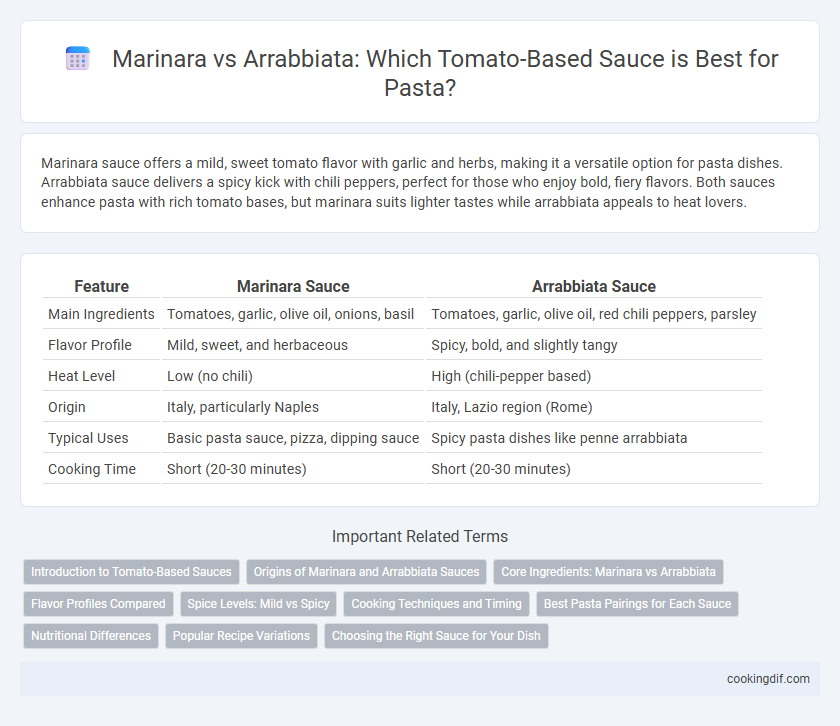Marinara sauce offers a mild, sweet tomato flavor with garlic and herbs, making it a versatile option for pasta dishes. Arrabbiata sauce delivers a spicy kick with chili peppers, perfect for those who enjoy bold, fiery flavors. Both sauces enhance pasta with rich tomato bases, but marinara suits lighter tastes while arrabbiata appeals to heat lovers.
Table of Comparison
| Feature | Marinara Sauce | Arrabbiata Sauce |
|---|---|---|
| Main Ingredients | Tomatoes, garlic, olive oil, onions, basil | Tomatoes, garlic, olive oil, red chili peppers, parsley |
| Flavor Profile | Mild, sweet, and herbaceous | Spicy, bold, and slightly tangy |
| Heat Level | Low (no chili) | High (chili-pepper based) |
| Origin | Italy, particularly Naples | Italy, Lazio region (Rome) |
| Typical Uses | Basic pasta sauce, pizza, dipping sauce | Spicy pasta dishes like penne arrabbiata |
| Cooking Time | Short (20-30 minutes) | Short (20-30 minutes) |
Introduction to Tomato-Based Sauces
Tomato-based sauces, such as marinara and arrabbiata, form the foundation of classic Italian pasta dishes, each offering distinct flavor profiles. Marinara sauce is characterized by its simple blend of tomatoes, garlic, onions, and herbs, creating a mild and versatile base. Arrabbiata sauce intensifies this profile by adding red chili peppers, delivering a spicy kick that complements robust pasta recipes.
Origins of Marinara and Arrabbiata Sauces
Marinara sauce originated in Naples, Italy, traditionally made with tomatoes, garlic, herbs, and olive oil, embodying simple, fresh flavors ideal for seafood dishes. Arrabbiata sauce comes from the Lazio region around Rome, characterized by its spicy kick achieved through the use of red chili peppers combined with garlic and tomatoes. These regional roots define their unique taste profiles, with marinara offering a mild, aromatic base and arrabbiata delivering a bold, fiery experience.
Core Ingredients: Marinara vs Arrabbiata
Marinara sauce features core ingredients such as tomatoes, garlic, onions, and fresh herbs like basil and oregano, providing a mild, slightly sweet flavor. Arrabbiata sauce, while also tomato-based, incorporates garlic and red chili peppers as key ingredients, delivering a distinctively spicy and bold taste. The primary difference lies in the heat level, with arrabbiata emphasizing chili-infused intensity compared to marinara's balanced and herbaceous profile.
Flavor Profiles Compared
Marinara sauce offers a mild, sweet tomato flavor enhanced by garlic, onions, and herbs like basil and oregano, creating a balanced and fresh taste ideal for a variety of pasta dishes. Arrabbiata sauce delivers a bold, spicy kick with crushed red chili peppers and garlic, providing a fiery contrast that energizes the tomato base. The distinct heat level in arrabbiata defines its intense flavor profile, while marinara remains approachable with its classic, savory richness.
Spice Levels: Mild vs Spicy
Marinara sauce is a mild tomato-based sauce seasoned with garlic, onions, and herbs like basil and oregano, offering a rich yet gentle flavor profile ideal for those preferring subtle spice. Arrabbiata sauce, originating from Italy's Lazio region, features a bold, spicy kick from crushed red chili peppers combined with garlic and tomatoes, delivering a hotter and more intense taste. The spice level difference is significant, with marinara catering to mild preferences while arrabbiata appeals to those seeking a fiery tomato sauce experience.
Cooking Techniques and Timing
Marinara sauce is simmered gently with garlic, onions, and herbs for about 20-30 minutes, allowing the tomatoes to break down into a smooth, mildly flavored base. Arrabbiata sauce requires a quicker saute of garlic and chili flakes in olive oil before adding crushed tomatoes, cooking for 15-20 minutes to maintain a spicy, robust flavor with a slightly thicker texture. Precise temperature control prevents bitterness in marinara and ensures the intense heat of chili peppers is balanced in arrabbiata.
Best Pasta Pairings for Each Sauce
Marinara sauce, with its mild garlic and basil flavors, pairs best with delicate pasta like spaghetti or penne, allowing the sauce's fresh tomato essence to shine. Arrabbiata sauce's bold, spicy profile complements robust pasta shapes such as rigatoni or ziti, which hold the fiery sauce well in their ridges. Choosing the right pasta enhances the texture and balance, highlighting marinara's simplicity and arrabbiata's intense heat.
Nutritional Differences
Marinara sauce typically contains tomatoes, garlic, onions, and herbs, offering a lower calorie count and reduced spiciness compared to arrabbiata, which includes hot chili peppers that increase its capsaicin content, potentially boosting metabolism. Nutritionally, marinara is rich in antioxidants like lycopene and vitamins A and C, while arrabbiata provides similar nutrients with added anti-inflammatory benefits from capsaicin. Both sauces are low in fat and sodium, making them healthy choices for tomato-based pasta dishes.
Popular Recipe Variations
Marinara sauce features a simple blend of tomatoes, garlic, onions, and herbs like basil and oregano, creating a mild and tangy base popular in traditional Italian pasta recipes. Arrabbiata sauce intensifies the flavor with red chili peppers, adding a spicy kick that complements penne and other pasta shapes favored in Roman cuisine. Both sauces showcase tomato as the key ingredient but differ significantly in heat level and regional taste preferences, influencing their usage in various pasta dishes worldwide.
Choosing the Right Sauce for Your Dish
Marinara sauce features a simple blend of tomatoes, garlic, onions, and herbs, offering a mild, sweet flavor ideal for pasta varieties like spaghetti or penne. Arrabbiata sauce incorporates chili peppers to create a spicy kick, making it a perfect match for dishes that need bold heat and robust tomato flavor, such as rigatoni. Selecting between marinara and arrabbiata depends on desired spice level and complementary ingredients, ensuring the sauce enhances the pasta without overpowering its texture.
Marinara vs arrabbiata for tomato-based sauces Infographic

 cookingdif.com
cookingdif.com